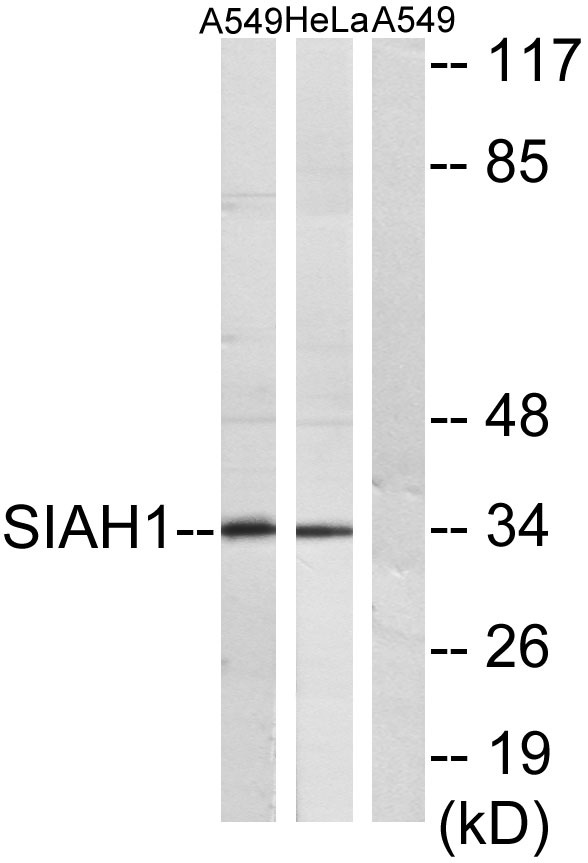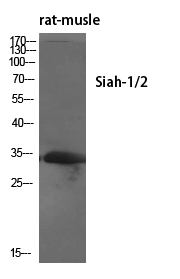产品名称
Siah-1/2 Rabbit Polyclonal Antibody
别名
SIAH1; HUMSIAH; E3 ubiquitin-protein ligase SIAH1; Seven in absentia homolog 1; Siah-1; Siah-1a; SIAH2; E3 ubiquitin-protein ligase SIAH2; Seven in absentia homolog 2; Siah-2; hSiah2
蛋白名称
E3 ubiquitin-protein ligase SIAH1/2
存储缓冲液
Liquid in PBS containing 50% glycerol, 0.5% BSA and 0.02% New type preservative N.
Human Gene Link
http://www.ncbi.nlm.nih.gov/sites/entrez?db=gene&term=6477
Human Swissprot No.
Q8IUQ4/O43255
Human Swissprot Link
http://www.uniprot.org/uniprotkb/Q8IUQ4/entry
Mouse Gene Link
http://www.ncbi.nlm.nih.gov/sites/entrez?db=gene&term=20439
Rat Gene ID
140941/140593
Rat Gene Link
http://www.ncbi.nlm.nih.gov/sites/entrez?db=gene&term=140941
Rat Swissprot No.
Q920M9/Q8R4T2
Rat Swissprot Link
http://www.uniprot.org/uniprot/Q920M9
免疫原
The antiserum was produced against synthesized peptide derived from human SIAH1. AA range:181-230
特异性
Siah-1/2 Polyclonal Antibody detects endogenous levels of Siah-1/2 protein.
稀释度
WB 1:500 - 1:2000. IHC 1:100 - 1:300. IF 1:200 - 1:1000. ELISA: 1:10000. Not yet tested in other applications.
宿主
Polyclonal, Rabbit,IgG
背景介绍
This gene encodes a protein that is a member of the seven in absentia homolog (SIAH) family. The protein is an E3 ligase and is involved in ubiquitination and proteasome-mediated degradation of specific proteins. The activity of this ubiquitin ligase has been implicated in the development of certain forms of Parkinson's disease, the regulation of the cellular response to hypoxia and induction of apoptosis. Alternative splicing results in several additional transcript variants, some encoding different isoforms and others that have not been fully characterized. [provided by RefSeq, Jul 2008],
组织表达
Widely expressed at a low level. Down-regulated in advanced hepatocellular carcinomas.
细胞定位
Cytoplasm. Nucleus. Predominantly cytoplasmic. Partially nuclear.
信号通路
p53;Ubiquitin mediated proteolysis;WNT;WNT-T CELL
功能
domain:The RING-type zinc finger domain is essential for ubiquitin ligase activity.,domain:The SBD domain (substrate-binding domain) mediates the homodimerization and the interaction with substrate proteins. It is related to the TRAF family.,function:E3 ubiquitin-protein ligase that mediates ubiquitination and subsequent proteasomal degradation of target proteins. E3 ubiquitin ligases accept ubiquitin from an E2 ubiquitin-conjugating enzyme in the form of a thioester and then directly transfers the ubiquitin to targeted substrates. Mediates E3 ubiquitin ligase activity either through direct binding to substrates or by functioning as the essential RING domain subunit of larger E3 complexes. Triggers the ubiquitin-mediated degradation of many substrates, including proteins involved in transcription regulation (MYB, POU2AF1, PML and RBBP8), a cell surface receptor (DCC), cytoplasmic signal transduction molecules (TIEG1 and NUMB), an antiapoptotic protein (BAG1), a microtubule motor protein (KIF22), a protein involved in synaptic vesicle function in neurons (SYP), a structural protein (CTNNB1) and SNCAIP. It is thereby involved in many cellular processes such as apoptosis, tumor suppression, cell cycle, axon guidance, transcription regulation, spermatogenesis and TNF-alpha signaling. Has some overlapping function with SIAH2. Induces apoptosis in cooperation with PEG3.,induction:May be induced by TP53/p53, suggesting that it may be required to modulate TP53 response. The relevance of such activity in vivo is however unclear and may not exist.,pathway:Protein modification; protein ubiquitination.,similarity:Belongs to the SINA (Seven in absentia) family.,similarity:Contains 1 RING-type zinc finger.,similarity:Contains 1 SIAH-type zinc finger.,subcellular location:Predominantly cytoplasmic. Partially nuclear.,subunit:Homodimer. Interacts with group 1 glutamate receptors GRM1 and GRM5. Interacts with DAB1, which may inhibit its activity. Interacts with UBE2E2. Interacts with PEG3 (By similarity). Component of some large E3 complex composed of UBE2D1, SIAH1, CACYBP/SIP, SKP1, APC and TBL1X. Interacts with UBE2I. Interacts with alpha-tubulin. Interacts with PEG10, which may inhibit its activity. Interacts with KHDRBS3.,tissue specificity:Widely expressed at low level. Down-regulated in advanced hepatocellular carcinomas.,
纯化
The antibody was affinity-purified from rabbit antiserum by affinity-chromatography using epitope-specific immunogen.


.jpg)
